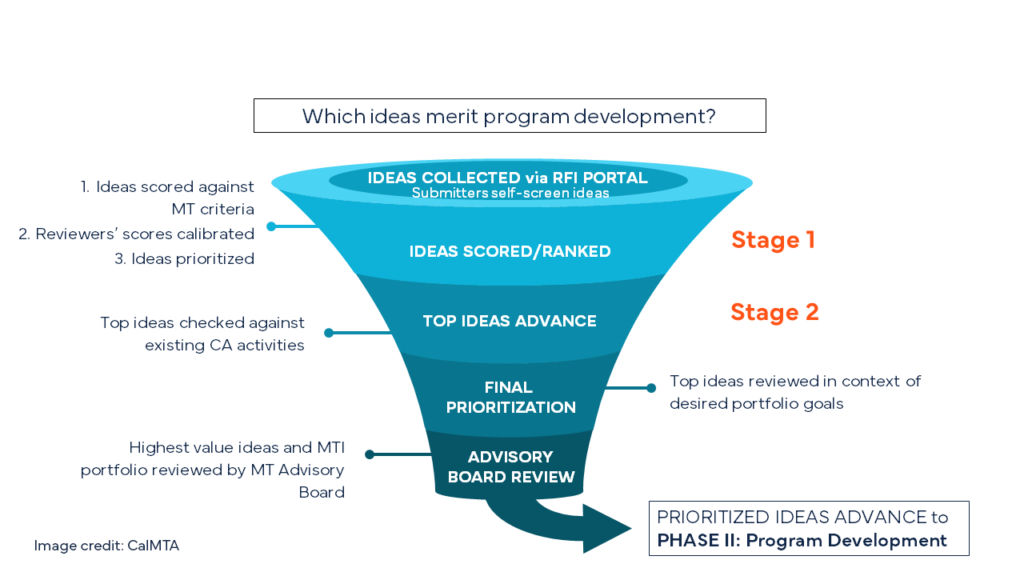Phase I: Concept Development
Overview
Phase I of the three-phase market transformation initiative (MTI) development process covers two stages, which relate to identifying and scoring potential market transformation ideas. Phase I concludes with the development of an Advancement Plan for viable market transformation ideas recommended to move to Phase II: Program Development. Advancements Plans describe the research and other investigation needed to develop the ideas into a full MTI Plan for consideration by the California Public Utilities Commission (CPUC). The steps in Phase I are depicted in the graphic and further described below.

Definitions of these steps can be found in the Stage 1 Disposition Report.
Phase I stages and activities
Stage 1: Ideation, Intake, Concept Scanning, and Identification
CalMTA accepts ideas from the public through an Idea Portal promoted through a Request for Ideas campaign. Proposals can also be self-developed by CalMTA staff but are also submitted to the Idea Portal, scored, and ranked via the process.
The CalMTA team reviews submitted ideas to ensure basic requirements are met, primarily that the ideas would save energy and provide enough information to be scored. After this threshold review, initial Stage 1 scoring of each idea is done to provide a basis for ranking them so that only those with the best potential are advanced to Stage 2 scoring. The Stage 1 scores are based on a clear set of criteria (see below) using the CalMTA team’s expertise and judgement to identify the concepts most likely to be effective MTIs.
CalMTA’s first RFI ran during summer 2023 to collect the initial batch of ideas. Read about the outcome of that solicitation. Our second RFI ran during summer 2024, and the report is under development. Register for the November Market Transformation Advisory Board (MTAB) meeting to learn more about the top-scoring ideas submitted during this RFI.

Stage 2: Concept Development and Assessment
During Stage 2 scoring, CalMTA, in collaboration with the Market Transformation Advisory Board (MTAB), further vets the top ideas. These are assessed with additional rigor around Total Systems Benefit (TSB) and cost-effectiveness potential. The Stage 2 scores are based on preliminary estimates developed using secondary data sources, research, and energy modelling.
In addition, a step during this stage includes a comprehensive portfolio review to ensure that the set of MTIs eventually selected deliver on desired portfolio characteristics. Highly ranked ideas from Stage 2 scoring move on to Advancement Plan development, which takes place over several months and describes the research and investigation needed to form a full MTI Plan. Advancement Plans are made available for public comment before finalizing.
For more details about CalMTA’s process and policies related to MTI development, visit our Policy Manual.
Scoring Categories & Criteria
The scoring categories and the individual criteria within each are presented in the table below. These are the same across Stage 1 and Stage 2, except for the criteria under Participant Cost & Cost-effectiveness. Because the Program Administrator Cost Test (PAC) and Total Resource Cost Test (TRC) are not calculated until Stage 2, the scorers’ assessment of the reasonableness of the participant cost is used in Stage 1.
| Category | Criteria |
| Total System Benefit (TSB)
A single metric that encompasses energy savings, grid benefits and reliability, and GHG impacts |
Energy TSB |
| Grid Benefits TSB | |
| GHG Impacts TSB | |
| Product Readiness
An indicator of the supply chain maturity/product availability |
Readiness |
| Participant Cost & Cost-effectiveness
Assesses the overall estimated cost of the MTI against its benefits |
Participant Cost (Stage 1)
PAC & TRC (Stage 2) |
| ESJ Impacts (Equity)
Assesses whether the MTI will provide beneficial impacts to ESJ communities or leverage existing community resources in its execution |
Beneficial Impacts to ESJ Communities |
| Partnership Opportunities with ESJ Communities | |
| Non-energy Impact
Captures the benefits or impacts (in addition to energy savings and greenhouse gas emissions reductions) that the MTI will deliver |
Non-energy Impacts |
| MT Alignment
Ensures that the MTI aligns with key aspects of MT theory and presents a strong MT opportunity |
Innovation Characteristics |
| Leverage Points | |
| Sustained Benefits |